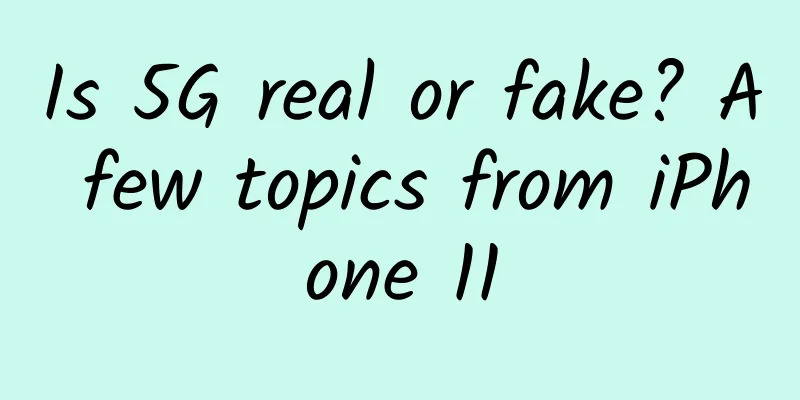Is 5G real or fake? A few topics from iPhone 11

|
The 2019 iPhone has been available for pre-order since last Friday. Since Apple no longer releases initial sales, whether this year's iPhone is well received by the market and whether sales are increasing or decreasing may only be known when Apple releases its fourth-quarter results early next year or when third-party data is released.
The biggest controversy about the iPhone this year is that it does not support 5G networks. Although Cook publicly explained that 5G networks are not mature and popular enough, Apple does not need to rush in; maybe, but even if Cook wants to use it, there is no baseband chip. Apple only reached a patent licensing and component supply agreement with Qualcomm in April this year, resulting in the 2019 iPhone not having time to use Qualcomm baseband chips, and can only continue to use Intel's baseband chips, and Intel cannot produce mature mass-produced 5G basebands. Therefore, Apple can only wait until next year to use 5G. Many people believe that 5G networks are not popular enough now, and it is completely possible for Apple to launch them next year. Many Apple fans even believe that 5G networks will not bring substantial improvements, and it does not matter whether they support them or not. Perhaps some of them are die-hard Apple fans who upgrade their iPhones every year, or have never experienced 5G networks (after all, only a few terminals in first-tier cities can experience 5G). There are indeed many different opinions and debates about whether we should buy 5G mobile phones now, when 5G networks will be popularized, what is the significance of 5G networks, and how to view NSA and SA network standards. Combining the actual progress of 5G networks and terminals in the United States and China, I will briefly talk about my views on several issues. This is purely a superficial viewpoint of a technology media person starting from the consumer field. It is just a starting point for discussion. Different opinions are welcome, and corrections from professionals in the communications industry are also accepted. 1. Should I buy a 5G phone now? The four major US operators are actively laying out 5G networks. Generally speaking, each operator will deploy 5G base station services in at least 8-10 first-tier cities by the end of the year. In contrast, under the guidance of national policies, China's state-owned operators have invested heavily in laying out 5G networks, and their deployment speed is significantly ahead of the United States, giving them a first-mover advantage in the 5G era. Market research firm Bernstein predicts that China will deploy 150,000 5G base stations by the end of this year, South Korea ranks second with 75,000 (South Korea has always been one of the best in network infrastructure), and the United States ranks third with only 10,000 base stations. By the end of 2020, China's 5G users will reach 100 million. China Mobile plans to build more than 50,000 5G base stations across the country this year, provide 5G commercial services in more than 50 cities, and provide 5G commercial services in all cities above the prefecture level next year. In fact, many areas in first-tier cities such as Beijing, Shanghai, Shenzhen, Guangzhou, and Hangzhou have already taken the lead in providing 5G services. China Unicom and China Telecom have also launched 5G network commercial/pilot in key first-tier cities. The charges for China's 5G services are not expensive. Wang Xiaochu, chairman of China Unicom, said last month that Unicom's 5G packages start at 190 yuan. China Telecom will launch a new 5G number segment in Beijing this month, with network packages starting at only 199 yuan. This is already sincere enough to popularize it. Therefore, if you are eager to be one of the first users to use 5G network services, then buying a 5G phone is the best way to enjoy it sooner rather than later. This does not mean that with a 5G phone, you can use the 5G network anytime and anywhere; but with a 5G phone, you can use the 5G network in more and more places first, and experience network services that are completely different from 4G. Moreover, China's 5G network coverage is getting larger and larger, and the pace of construction is getting faster and faster. In the future, the experience will only become more and more perfect. 2. Each company has a 5G flagship In fact, among the mainstream manufacturers, only Apple does not have a 5G flagship, and some manufacturers have even released two. In the United States, Apple's home turf, Samsung, LG, Motorola, and OnePlus have already or are about to release 5G flagships; while in China and the international market, Huawei, vivo, OPPO, Xiaomi, and ZTE have also successively launched 5G leaders. Apple can only blame itself for having previously trusted Intel's baseband business and rashly got into a patent battle with Qualcomm, missing the first batch of opportunities. The prices of 5G flagships released in the Chinese market this year are cheaper than iPhones of the same grade, and there are many choices. The prices of many manufacturers' products range from 3798 yuan to 7999 yuan, from mid-range vivo to high-end Samsung, it can be said that people can afford it. It is particularly worth mentioning that the starting price of the iQOO Pro 5G previously released by vivo is only 3798 yuan, which directly lowers the price of 5G terminals with Qualcomm's latest Snapdragon 855 Plus chip to less than 4000 yuan. This may be the most cost-effective 5G flagship phone in China. In such a market competition environment, the starting price is as low as 5,500 yuan (once again, complain about the sneaky practice of starting at 64GB, other manufacturers start at 128GB, and the 128GB iPhone 11 costs 5,999 yuan), and the high-end iPhone 11 series, which even costs more than 10,000 yuan, does not support 5G networks, which is indeed embarrassing. I don’t think it’s worth spending so much money on a high-end phone when you can’t enjoy the latest commercial communication technology services now or in the future. Besides, apart from the die-hard Apple fans who change their phones every year, I believe that ordinary users will use their iPhones for at least three years. In short, 5G may not be an essential feature of smartphones in 2019, but it is definitely a sign of flagship phones. 3. NSA or SA? The debate over the two standards of non-standalone networking and standalone networking has also been a focus of debate among some domestic readers recently. As the names suggest, one is the 5G networking method NSA based on the upgrade and transformation of 4G base stations, and the other is the 5G networking method SA that is completely independently built end-to-end. The two sets of standards also have their own advantages and disadvantages. Personally, I think the difference between NSA and SA is not true or false, but an evolutionary relationship that is at different stages, facing different terminals, and bringing different improvements. It can be called early 5G and full 5G. Specifically, NSA can help operators save costs and quickly build 5G networks by using the existing 4G core network without investing a lot of extra money, so that consumers can enjoy the ultra-high speed (large bandwidth) mobile Internet characteristics of the 5G network as soon as possible. It can be said that NSA is 5G for consumer terminals, which brings improved experience in ultra-high-definition video, cloud collaboration, AR/VR, etc. SA requires operators to invest more money to rebuild a new network, which cannot replace the existing 4G network base stations. However, the SA network standard can fully reflect the three major characteristics of 5G networks: ultra-high-speed eMBB, ultra-large-connection mMTC, and ultra-low latency uRLLC, and truly realize the potential of the Internet of Everything. It can be said that SA is not only aimed at ordinary consumer terminals, but also at many commercial fields such as the Internet of Things, smart cities, drones, unmanned vehicles, telemedicine, online education, etc., bringing real productivity improvements such as cloud computing and artificial intelligence. At present, most operators around the world are adopting the "NSA first, then SA" 5G network deployment strategy. The reason is also easy to understand. Operators use the 4G base stations that they have invested heavily in to build NSA standard 5G services, which can not only save costs, but also allow them to commercialize and occupy the market as soon as possible. However, China lagged behind the world in the 3G and 4G eras and is eager to take the lead in the 5G era. This national science and technology strategy has prompted operators to develop NSA networks in line with commercial interests while also focusing on developing SA networks in accordance with national needs, pushing China to realize the three major features of 5G networks earlier than other countries and driving a real leap in productivity. China's three major operators chose to build networks in NSA mode in the early stage of 5G commercialization, and gradually transition to SA. China Mobile, which has the clearest position, will promote the development of NSA and SA simultaneously. All 5G base stations by the end of this year will support both NSA and SA. 4. Will the use of NSA be banned next year? This is a typical case of quoting out of context. Yang Jie, chairman of China Mobile, said at the MWC Shanghai that "the Chinese government has made it clear that starting from January 1 next year, 5G terminals must have SA mode, and NSA phones will not be allowed to access the network." Some self-media people only took out this sentence and made it into a rumor that "NSA standard phones will not be usable next year." In fact, if we combine Yang Jie's full speech on that day, we will find that his meaning is very clear: due to the government's position, 5G mobile phones sold next year must support both NSA and SA, not just NSA mode. The exact meaning of that sentence is that mobile phones that only support NSA cannot be connected to the network in China. This is because most operators in the world are starting to build 5G networks from NSA, so most 5G phones initially support NSA, and only a handful support SA. Qualcomm's 5G baseband chip also only supported NSA at the beginning, and then it launched the X55 chip that supports both networking modes. In order to vigorously develop SA and promote operators and terminal manufacturers to cooperate with this strategy, China requires 5G terminals to support both network standards. However, a 5G mobile phone must support both NSA and SA standards, which is completely different from "NSA standard mobile phones cannot be used". So what is the attitude of operators? "5G base station investment is twice that of 4G, and power consumption is 2.5 to 3 times. I hope that operators can invest less in the future and get greater returns with less investment." This was the speech of Yang Jie, chairman of China Mobile, at the event on the same day. He also said that China Mobile will make full use of 4G site resources to build 5G and achieve rapid network deployment. 5. There is no need to worry about buying a mobile phone for the time being Personally, I think that as an ordinary consumer, when buying a smartphone in 2019, there is no need to worry about NSA or SA networking. Because the 5G network characteristics that are truly experienced on smartphones are actually large bandwidth characteristics, in layman's terms, high download speeds, which NSA can directly provide. The full potential of 5G brought by SA is more about breakthroughs in ultra-large connections and ultra-low latency, which involves more than smartphone terminal users. In addition, although Chinese operators are investing in the construction of 5G networks with great enthusiasm, and their network coverage and expansion speed are also leading the world, even the NSA standard 5G network based on the transformation of the 4G network will conservatively take several years to reach the coverage of the current 4G network. The independent SA standard 5G network requires a longer network construction cycle, and it may take even longer to reach the coverage of the 4G network. This is of course because the deployment of 5G networks requires a lot of money and time. Let's review the commercialization and popularization speed of 3G and 4G networks in China. China issued 3G licenses to the three major operators in January 2009 (commercial use began in the second half of 2009), 4G licenses in December 2013 (commercial use began in the second half of 2014), and 5G licenses in June 2019 (commercial use began in the second half of 2019). The upgrade from 3G to 4G and from 4G to 5G took about 5 years. During the transition period of the next few years, China's mobile communication network will be in a stage of mixed use of 5G and 4G. At present, most countries in the world are developing NSA first for 5G, and will be in a stage of coexistence of 5G+4G. This is also the normal path of communication network development. I think that if your city already has a 5G network or is about to be commercially available, you don't need to consider whether to use NSA or SA when buying a not-so-expensive 5G phone. How long does a smartphone last? Three years is the limit, right? Buy it early and enjoy the latest technology experience early. |
<<: Android 11, a detailed account of the vivid history from version 1.0 to 10.0
>>: WeChat released a new version, there are 3 design details worth paying attention to!
Recommend
How far are we from domestic brands launching OLED TVs?
About ten years ago, LCD TVs sounded the clarion ...
The height of Mount Everest is affected by it! The latest data shows →
On July 8, the reporter learned from the Second Q...
The higher the alcohol concentration, the better the disinfection effect? This statement is really wrong!
When it comes to medical alcohol, everyone is fam...
ChatGPT is almost one year old! How did it develop such fluent conversation skills?
ChatGPT will be one year old in November this yea...
How can submarines be “sharp-eyed and sharp-eared” in deep-sea operations? ——The scientific principles of submarines from Operation Jiaolong
As the sequel to "Operation Red Sea", t...
Still worried about promotion? Here is a list of promotion channels for your reference
For operations , user volume and revenue are the ...
Are you still mixing umbrellas and parasols when the rain and sun come one after another? Stop it →
Many friends complained during the flood season, ...
Seeding + live streaming, a complete guide to playing Douyin on Double Eleven
The annual Double Eleven Carnival is about to beg...
Why do we love drinking boiled water?
When it comes to drinking boiled water, I believe...
520 copywriting topic marketing
How to do topic marketing on 520? We will proceed...
Snapdragon 820 version of Samsung S7 latest running score exposed: a new high
As the release is approaching, Samsung S7 is also...
How to reduce user churn through effective operational activities?
The “Double 12” promotion kicked off the year-end...
How does Baidu bidding creative match keywords?
I am building 3 promotion groups (promotion units...
Top 6 latest Christmas advertisements in 2020, the creativity is amazing!
As a traditional Western festival, Christmas has ...
Official reminder! Be careful when eating this kind of rice noodles recently, as it may cause death!
Expert of this article: Fu Shufang, Master of Foo...









